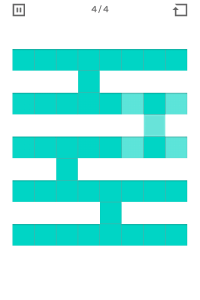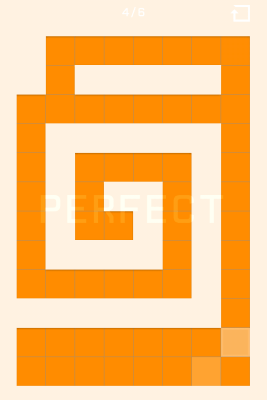After the aesthetic elegance of Dots, prepare for another injection of minimalist puzzle game beauty. Blip Blup is the new game from London-based design house and app studio ustwo — maker of Whale Trail, a mobile game that snagged an e-book deal, plus a raft of other interesting apps including most recently Rando (random photo-sharing) and Honk (visual messaging).
Blip Blup has just launched on iOS for iPhone and iPad, either free with ads, or $1.99 ad free. It’s also available free with ads on Android (upgradable to ad-free via in-app purchase). The basic gameplay involves triggering pulses of light so that they fill in all the empty space in each level. Light pulses can be blocked by walls, and won’t travel around corners but will travel diagonally. There are also other elements introduced as your progress, such as arrows that force the direction of the light and explosive tiles to avoid. The fewer light pulses (blips) you use to fill in a level, the higher your score.
The first thing that stands out about Blip Blup is that ustwo has gone for a minimalist, abstract design aesthetic, rather than a skeumorphic look and feel — despite apparently experimenting with the latter. Too much realism just didn’t fit the puzzle gameplay, says ustwo. “Getting to the final treatment was an exercise in finding a balance between our love for beautiful design as a studio and simple graphics that allow the puzzle-solving to be centre-stage,” it explains in a blog.
“Skeuomorphic design in this instance would have stifled the complex puzzle solving nature of Blip Blup,” adds ustwo co-founder Matt Miller. “The puzzle and the solution needed to be at the front and centre stage with nothing getting in the way of that focus. We believe in the core gameplay of Blip Blup and feel that the minimal design supports that without overwhelming it with unnecessary graphics.”
Miller says Blip Blup is designed specifically to appeal to people who are also interested in visual design, and who therefore might not be turned on by traditional gaming aesthetics. “Over the past decade and as a direct result of mobile app-based gaming, gamers have increased in terms of numbers and diversity. This shift has meant that creators, who previously had to appeal to large and ‘safe’ audiences, can instead cater to more specific and targeted audiences. For example appealing to players who are interested in interacting with great visual design, rather than those who prefer cartoon characters and fantasy locations,” he tells TechCrunch.
“Minimalist design in game visuals presents interesting challenges. In a way, you are reducing your available visual toolset, to a few essential tools. But with these tools, you still need to convey success and failure, important objects, objects that are on or off, and so on.
The mass audience definitely reacts favourably to matching shiny gems together, or seeing projectiles strike a tower of glass and wood blocks. But there’s an audience out there that love the cleanliness of a grid, or the satisfaction of filling an abstract space completely with colour even more.”
“We see visual design and interaction design as one area in gaming and this means we can ultimately create new experiences and potentially speak to a new audience,” he adds.
Blip Blub’s minimalist design certainly brings to mind betaworks’ Dots (not least because ustwo wanted to call it just Blip, before realising that name had been taken), which also recently caught our eye. Or even Peter Molyneux’s Curiosity. But with so many mobile games still opting for a cartoon aesthetic — a la Angry Birds — taking a different tack by stripping back the visuals feels refreshing — likely making these puzzlers stand out more than they would have on gameplay alone. It also seems to echo the wider digital design trend that’s been flattening graphics and decluttering visuals all over the web and mobile, doing away with realistic bells and whistles and replacing them with plain blocks of colour to allow shapes to shine through.
Blip Blub doesn’t feel entirely flat — the light pulses move via subtle colour gradations — but it’s certainly minimalistic. Its look is complemented by an ambient soundtrack that weaves in gameplay actions, with each light pulse adding a few more notes to the soundscape. (In fact ustwo says the sound is “50% of the Blip Blup experience”.) The overall effect is reflective, meditative and very relaxing. This would be a great game to play to destress after a hard day.
The slow, relaxed paced is matched by the gradual gameplay progression, with basic tutorial puzzles leading you step by step to proper levels and from there turning the screw to up the difficulty by adding new elements to the mix. There are 120+ puzzles in the free game distributed across nine levels, and 140+ across 10 levels in the paid game.
